This article which follows pertaining to How to Fix a Water Damage Bathroom is fairly remarkable. You should check it out.

The restroom is very at risk for moist build-up and potential water damage because of the regular use water in it. This write-up supplies simple evaluation methods to assist identifying water damages hazards.
The frequent use of water in the restroom makes it very prone for wet buildup and also possible water damages. By inspecting it regularly, you can reduce water related damages.
The following set of evaluations is simple to carry out as well as ought to be done when in every 3 months in order to maintain your washroom healthy and also to stop possible water problems triggered by the tub, the shower, pipe joints as well as plumbing, sinks, cupboards, and the toilet
Do not neglect performing these examinations and also be detailed while doing them. Bear in mind that these easy evaluations can save you a great deal of cash by supplying very early indicators for water damage
Sinks and Cabinets
Sinks and also closets are revealed to wetness and humidity day-to-day and also are commonly neglected. Examine routinely under the sink and on the kitchen counter over it. Repair any drip in the catch as it might suggest drainpipe troubles. Browse the sink, slow draining pipelines might indicate an obstructed drainpipe. Replace sink seals if they are cracked or loosened.
Tub and Shower
The shower and also tub require unique interest and upkeep. Inspect the tiles and also change if cracked. See to it that there is no missing out on grout in between the ceramic tiles. Inspect and also replace fractured caulking at joints where the wall surfaces meet the flooring or the tub. Obstructed drains pipes and pipelines problems will certainly avoid the bathtub from drying out and might indicate significant issues beneath the tub. Consult with a specialist right away to stop structural damages. Focus on stainings or soft areas around the bath tub walls as they might suggest an inner leak.
Plumbing
Signs for water damages are hard to find given that many pipelines are installed inside the wall surfaces.
Pay special interest to flooring as well as wall surfaces moisture as well as stains as they may show an unnoticeable plumbing trouble. Check wetness degrees in adjoining spaces as well.
The Bathroom
The commode is a vulnerable water joint. Examine the water lines and search for leakages around the commode seat, in the tube, and under the water storage tank. If you find any kind of signs of wetness on the floor around the bathroom, look for leakages in the toilet rim and storage tank seals.
Know that hanging commode dish deodorants increases the possibilities for blockages.
TIPS TO PREVENT WATER DAMAGE IN THE BATHROOM
The average household uses approximately 80-100 gallons of water per person per day. For a family of 4, that's almost 2,500 gallons of water a week! The largest portion of this consumption comes from bathroom use. Flushing the toilet uses the most water, followed by taking a shower or bath. With that much water running through the home, water damage in the bathroom is bound to happen. Knowing how to spot signs of a water leak is essential to preventing long-term damage. This guide provides you with tips to reduce the impact of water damage on your bathroom.
CAUSES OF BATHROOM WATER DAMAGE
Pipe breaks are the most common cause of water damage we see in our daily jobs. The age of a pipe plays a large role in a pipe break as well as corrosion. Over time, the metal begins to break down, allowing water to escape. Frozen pipe breaks are also a concern in the winter months. Toilet overflows caused by paper products or children flushing inappropriate items. Degraded caulking around the toilet or bathtub can allow water seepage, sometimes behind the fixture, into the subfloor or walls. Condensation forms when the water in a pipe is cooler than the air temperature. Beads of water form on the exterior of the pipes, sometimes so much so that the water begins to drip and pool below. Sink or shower backups created by poor drainage. HOW TO PREVENT WATER DAMAGE IN YOUR BATHROOM
Inspect your toilet supply line for worn or frayed hoses and replace them as needed. Winterize your plumbing to prevent a frozen pipe break. Use vent fans to prevent condensation that can lead to mold growth. Routinely check and replace degraded caulking around your toilet or bathtub. Increase the temperature in your toilet tank and insulate your pipes during the warm summer months to keep condensation from forming. Use child safety locks on the toilets. Flush only toilet paper. "Flushable" wet wipes are actually not good for your plumbing system. Additionally, feminine hygiene products should not be flushed. Prevent water from escaping the tub or shower. Make sure shower curtains are in good condition. Inspect shower doors and replace the seal strip if necessary. Wipe up any water that accumulates on the floor and use bath mats. Water left to sit can cause damage to the tiles and flooring. Refrain from using bath products containing heavy oils to avoid a clogged drain.

Do you enjoy reading up on Common Causes of Water Damage in a Bathroom? Leave feedback further down. We would be delighted to find out your reactions about this write-up. We hope that you visit us again before long. Do you know about another person who is very much interested in the subject? Take a moment to share it. I truly appreciate reading our article about How to Repair and Prevent Bathroom Water Damage.
Estimate Free